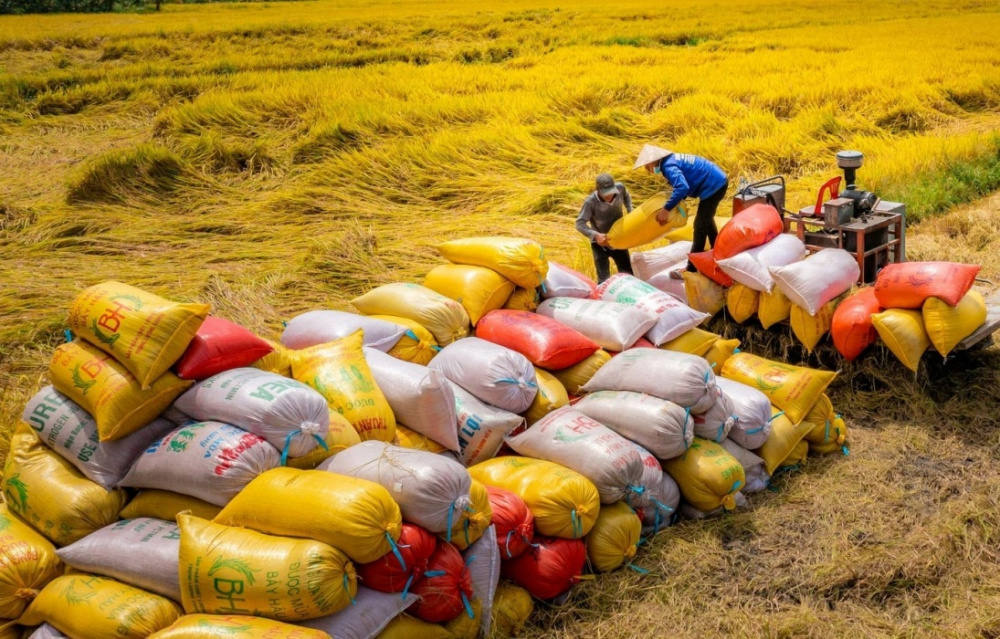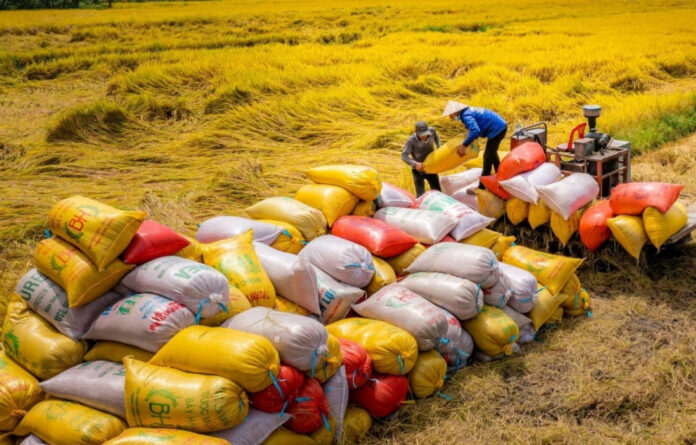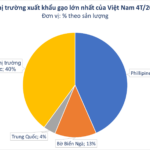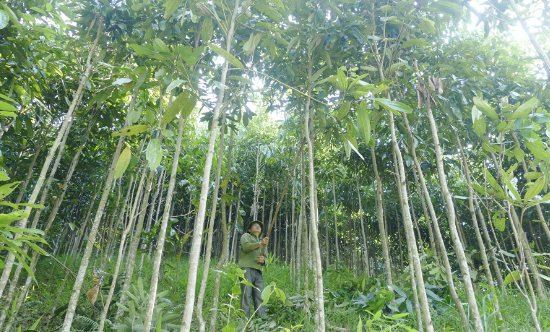The Vietnamese rice industry is facing significant challenges due to a sharp decline in export prices, urging the need to enhance product quality and build a sustainable brand for Vietnamese rice.
Plummeting Rice Export Prices
Since the beginning of 2025, Vietnam’s rice export prices have dropped to their lowest level in nine years. As a result, while Vietnam’s rice export volume has increased, its turnover has significantly declined due to lower average selling prices. Excess global supply and weakened demand from key markets are posing risks to domestic enterprises in terms of profits and market share.
Specifically, the price of 5% broken rice has fallen to $399 per ton, $34 lower than that of Thailand’s rice of the same type. The prices of 25% broken rice and 100% broken rice have also dropped significantly to $371 per ton and $313 per ton, respectively.
The average export price for the first five months of 2025 is estimated at $516.4 per ton, an 18.7% decrease compared to the same period in 2024. Thus, it can be seen that the average export price in the first five months has dropped by 20% year-on-year, mainly due to the surge in global supply coupled with weakened demand.
The primary reason for this decline is India’s relaxation of rice export restrictions after two years of tight control, increasing international market supply and creating competitive pressure for other rice-exporting countries, including Vietnam. Additionally, the demand for imports from major markets such as the Philippines and Indonesia is decreasing as these countries have accumulated sufficient reserves in 2024 and are waiting for further price drops before importing again.
In fact, the drop in export prices has directly impacted domestic rice prices. In the Mekong Delta, the price of IR 504 (fresh) rice decreased by VND 700/kg, fluctuating between VND 5,500 and VND 5,700/kg; OM 5451 rice decreased by VND 700/kg, ranging from VND 5,800 to VND 6,000/kg. Many farmers are concerned about potential losses due to high input costs and declining rice prices.
Meanwhile, rice export enterprises are also facing difficulties due to a significant drop in the number of orders. Many businesses reported no signed contracts for exports in February, presenting a significant challenge in maintaining stable production and exports.
Additionally, they face intensified competition from other rice-exporting countries. India’s return to the market, with an expected export volume of 22 million tons in 2025, an increase of 5 million tons compared to 2024, has created fierce competition for other rice-exporting countries. Thailand and Pakistan are also ramping up their supply to seize export opportunities. This situation puts Vietnam under greater competitive pressure, especially with its current low rice export prices.
The Vietnam Food Association forecasts that rice exports in 2025 may reach only about 7.5 million tons, a decrease compared to the figure of over 9 million tons in 2024.
Opportunities in the High-Quality Rice Segment
In a discussion with the press, Mr. Huynh Tan Dat, Director of the Plant Protection and Environment Department (Ministry of Agriculture and Environment), stated that the rice industry is facing dual challenges, both from the market and production. Therefore, a more flexible approach is necessary for Vietnamese rice export enterprises at this juncture.
It is important to note that while export prices have declined, the fragrant and high-quality rice segments have maintained stable prices. Many enterprises are still exporting fragrant and specialty rice at prices ranging from $800 to $1,200 per ton. Currently, there are contracts for exporting ST25 specialty rice at prices exceeding $1,000 per ton. This indicates that focusing on enhancing product quality and building the Vietnamese rice brand can help the industry overcome current difficulties and achieve sustainable development in the future.
To address the current challenges, the Vietnamese rice industry needs to improve product quality, invest in research and development of high-quality rice varieties that meet market demands, and implement supportive policies for farmers and enterprises in accessing capital, technology, and market information. It is crucial to build the Vietnamese rice brand, enhance promotion and marketing efforts, and raise brand awareness in the international market.
An urgent measure is to diversify export markets, seek and expand into new markets, and reduce dependence on traditional markets. According to agricultural experts, by focusing on product quality improvement, brand building, and market diversification, the Vietnamese rice industry can overcome challenges and achieve sustainable development in the future.

The Vietnamese rice industry needs to improve product quality
From a management perspective, to facilitate policies for rice exports, the Ministry of Industry and Trade is seeking opinions on the draft decree amending and supplementing a number of articles of Decree 107/2018/ND-CP on rice export business and Decree 01/2025/ND-CP amending and supplementing a number of articles of Decree 107/2018/ND-CP.
However, recently, the Vietnam Chamber of Commerce and Industry (VCCI) has provided feedback on the draft decree amending and supplementing Decree 107/2018/ND-CP and Decree 01/2025/ND-CP on the rice export business. VCCI stated that the current regulations are causing difficulties for enterprises, increasing costs, hindering market entry, and restricting the freedom to do business.
For instance, the requirement for rice export traders to own warehouses for storing paddy and rice is considered restrictive by VCCI, as it implies that enterprises are not allowed to rent warehouses as per the current regulations.
Furthermore, VCCI suggested removing the provision that “new traders must reserve 1,250 tons of rice within 45 days of obtaining the license.” This requirement significantly increases the conditions for new enterprises to enter the market. VCCI analyzed that in the absence of signed export contracts, the requirement to import and reserve a large amount of rice would force enterprises to mobilize substantial capital and incur unnecessary costs related to warehousing and preservation. This does not take into account the potential challenges enterprises may face in terms of paddy and rice reserve procurement…
“The Media: A Driving Force for Spreading Corporate Culture”
In the ever-evolving landscape of media and communications, the press must continue to innovate and lead the way in promoting ethical values and corporate cultural standards. It is imperative that the press forges ahead, standing alongside private enterprises as they assert their positions and contribute to the growth of Vietnam’s economy, elevating its stature in the region and on the global stage.
The Dark Side of the Food Industry: Exposing the Dangers of Contaminated Produce and the Need for Stronger Regulations
“Speaking to Tien Phong, a renowned expert in commerce and market management conceded that there is often a game of passing the buck between various units and ministries when issues pertaining to their domains surface. In light of the recent exposés of numerous incidents involving tainted food, counterfeit medicines, and fake milk, it is indisputable that the Ministry of Health bears the primary responsibility.”
The World’s Second-Largest Economy Hunts for a Surprising Commodity from Vietnam: A Surprising Surge in Exports and 20 Million Tons of Annual Production
Vietnam is one of the top three exporters in the world, a powerhouse in the global market with an incredible capacity to produce and ship goods internationally. With a diverse range of products, from electronics to agricultural produce, Vietnam has firmly established itself as a key player in the realm of international trade. The country’s economic prowess and ability to cater to the demands of a global market are truly remarkable.
“Completed Projects Left Unsold Due to Lack of Land Appraisal, While Some Areas Witness a Doubling of Land Prices Within Just Six Months”
This is a statement from Mr. Nguyen Quoc Hiep, Chairman of GP. Invest and the Vietnam Association of Building Contractors, at the forum “Sustainable Development of the Real Estate Market – Awarding the Livable Project Certification 2024” organized by the Enterprise Forum on the morning of November 27th.





















